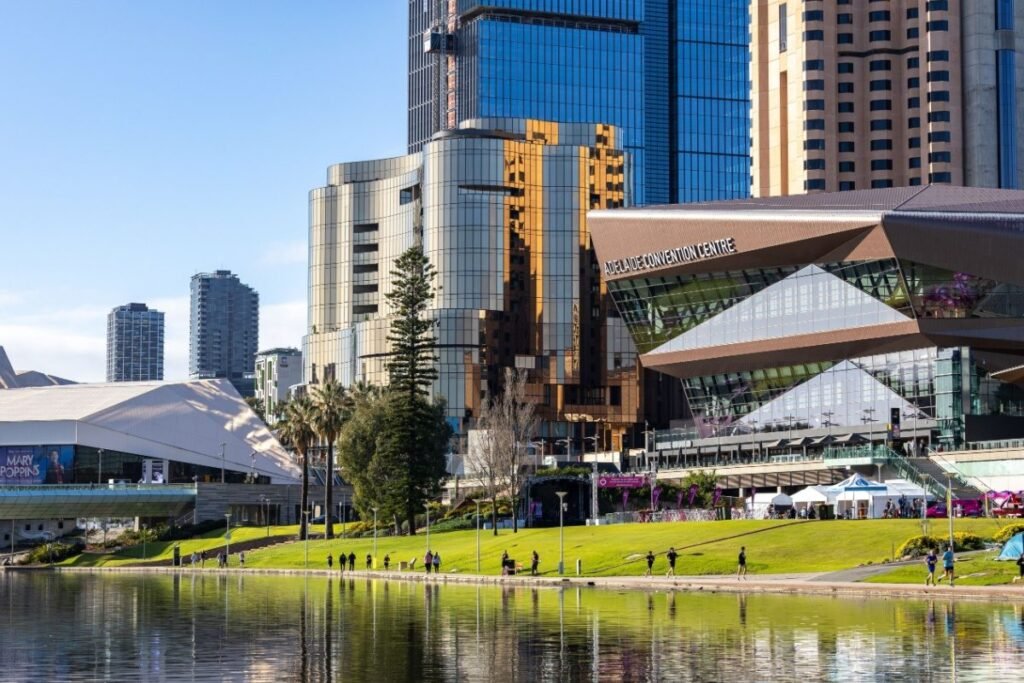Cultural Heritage of Adelaide: A City Rich in History and Tradition
7 months ago

Adelaide, the capital city of South Australia, is often recognized for its vibrant arts scene, delectable food culture, and stunning coastal views. However, beneath the modern facade lies a profound cultural heritage of Adelaide that intertwines the narrative of its Indigenous heritage as well as the influences of European settlers. This article aims to explore the multifaceted layers of Adelaide's cultural heritage, highlighting the city’s historical events, traditions, and the significant contributions each culture has made to its identity.
The Unley Road, the bustling West End, and the picturesque Adelaide Hills all serve as reminders of the cultural heritage of Adelaide, which brilliantly captures a blend of past and present. The city was founded in 1836, designed with a systematic layout that emphasized social equality, yet even before the European settlers arrived, the region was inhabited by the Kaurna people. Understanding the cultural heritage of Adelaide necessitates a deep dive into its Indigenous roots, the European influences that followed, and how this potent mixture shapes the city today.
Indigenous Heritage and the Kaurna People
To grasp the essence of the cultural heritage of Adelaide, one must first acknowledge the Kaurna people, the traditional custodians of the land. The Kaurna language, which had once been nearly forgotten, is now experiencing a revival, fueled by the community’s efforts and academic support. The reclamation of their language is not only a significant step towards preserving their identity but also an avenue through which the stories of their ancestors are shared with newer generations.
The landscape of Adelaide holds great significance in the cultural heritage of Adelaide. The Kaurna people maintained a deep relationship with the local flora and fauna, their cultural practices being intricately intertwined with the seasons and cycles of nature. Understanding these connections—between the land, the community, and their cultural heritage—provides insight into how this Indigenous group has maintained traditions despite colonial disruptions.
Local Legends and Dreamtime Stories
The cultural heritage of Adelaide is rich with stories passed down through generations in the form of legends and Dreamtime stories. These tales illustrate the spiritual beliefs of the Kaurna people and impart moral lessons. They speak of the creation of the landscape, the animals, and the relationship between the spiritual and physical worlds. Each story not only preserves the cultural heritage of Adelaide but also provides insight into how the Kaurna people perceive the world around them.
One well-known story within Kaurna culture, for example, describes the creation of the Mount Lofty Ranges, attributing its formation to a significant event involving ancestral beings. These narratives foster a connection between the Kaurna people and their land, ensuring the continuation of their cultural legacy. Today, efforts are in place to share these Dreamtime stories through various art forms, community events, and educational programs, thus enriching the cultural heritage of Adelaide further.
European Settlement and Colonial Influences
While the Indigenous roots provide a strong foundation to the cultural heritage of Adelaide, the arrival of European settlers marked a new chapter in the city’s historical timeline. Founded as a free colony in 1836, Adelaide was envisioned by its founders as a model of social progress, which was demonstrated in its well-planned layout and emphasis on public parks and squares. This contrasted significantly with other colonies established in Australia, which had primarily been founded for penal transportation. The architectural influences, cultural institutions, and governance structures set forth by European settlers have all played essential roles in shaping the cultural heritage of Adelaide.
The impact of British architecture on Adelaide’s landscape is particularly notable. From the stunning Victorian-era buildings that line the city’s streets to the grand churches that punctuate the skyline, these structures serve as lasting representations of the architectural prowess and cultural ideals that accompanied settlers. Sites like the Adelaide Gaol, built in 1841, and the State Library of South Australia reflect both the colonial past and the intricate layers of history contained within the cultural heritage of Adelaide.
Cultural Institutions and Their Contributions
As Adelaide continued to grow, it emerged as a cultural hub, thanks in part to the establishment of various institutions dedicated to preserving and promoting art, science, and education. The Cultural heritage of Adelaide manifests vividly in institutions such as the Art Gallery of South Australia, housing an impressive collection of Australian and Indigenous art. This gallery not only showcases creative talents but also facilitates dialogue about social issues, heritage, and identity through its exhibitions and community programs.
Furthermore, the South Australian Museum serves as a repository of cultural artifacts, history, and science, offering the public insights into South Australia’s natural history as well as Indigenous cultures. It is a place where the cultural heritage of Adelaide is not just preserved but actively celebrated through educational initiatives and interactive displays that raise awareness about the Kaurna people's ongoing connection to this land.
Cultural Festivals and Celebrations
The cultural heritage of Adelaide is vibrantly displayed through a myriad of festivals and celebrations. The Adelaide Festival, held annually in March, is a cornerstone event celebrating the arts. It brings together local, national, and international performers, creating a platform for exploration and expression that reflects the city’s diverse cultural landscape. This festival is more than just a series of performances; it weaves the stories of various communities into its fabric, allowing the audience to understand the multifaceted aspects of Adelaide’s cultural heritage.
In addition, events such as the WOMADelaide festival highlight the city’s commitment to multiculturalism and the arts. This music and arts festival attracts performers from around the globe, showcasing diverse cultural expressions and encouraging community engagement. It illustrates how the cultural heritage of Adelaide is enriched by the global influences that interweave with its local traditions and narratives.
Food Culture and Culinary Heritage
One cannot discuss the cultural heritage of Adelaide without mentioning its food culture, which is intrinsically tied to both local produce and immigrant influences. The Adelaide Central Market, one of the largest fresh produce markets in Australia, stands as a testament to the city’s agricultural bounty and the culinary heritage shaped by early settlers as well as recent migrants. Visitors are treated to a rich tapestry of flavors, from traditional Australian dishes to international cuisine reflecting the diversity of the community.
Moreover, the city’s wine regions, particularly the Barossa Valley and Adelaide Hills, play a crucial role in shaping its culinary landscape. The local wineries not only contribute to the economy but also offer a glimpse into the European influence on food and wine culture in Adelaide. Wine tasting tours, culinary festivals, and farm-to-table experiences enable residents and visitors alike to engage deeply with the cultural heritage of Adelaide through the senses of taste and smell.
Arts and Crafts: From Traditional to Contemporary
The artistic endeavors found within Adelaide are a robust representation of its cultural heritage, showcasing both traditional Indigenous art forms and contemporary works. Indigenous artists continue to play a significant role in this narrative, employing techniques that have been passed down through generations while also experimenting with modern expressions. The integration of traditional storytelling and imagery into contemporary art serves to educate wider audiences about the significance of Aboriginal culture and its ongoing relevance in today’s society.
On the other hand, the vibrant contemporary art scene in Adelaide is often highlighted during the Adelaide Biennial of Australian Art, which features the work of emerging and established artists from across the nation. This biennial not only provides a platform for artists to showcase their work but also stimulates conversations about themes of identity, society, and the environment, further enriching the cultural heritage of Adelaide.
Education and Preservation of Cultural Heritage
Recognizing the importance of preserving its cultural heritage, Adelaide has initiated several educational programs aimed at promoting awareness and understanding of both Indigenous and European histories. Schools in the region incorporate elements of Indigenous history into their curricula, allowing students to appreciate the prolonged history of the land they inhabit. Programs featuring local elders returning to schools to share traditional stories and knowledge are vital in building a stronger connection between the past and future generations.
Moreover, museums and cultural institutions often collaborate with schools and community groups to host workshops, performances, and exhibitions that foster appreciation for the diverse aspects of Adelaide’s cultural heritage. These initiatives not only educate the public but actively involve them in the preservation and celebration of the city’s unique identities, ensuring that the voices of the past continue to resonate.
Conclusion
The cultural heritage of Adelaide is a rich tapestry woven from the threads of its past and present. From the profound connections with the land held by the Kaurna people to the bold European influences that shaped its infrastructure and societal layout, Adelaide stands as a city that both cherishes its history and embraces the future. Through festivals, art, cuisine, and educational programs, the city’s inhabitants strive to foster a lasting appreciation for its diverse cultural landscape.
As conversations around cultural heritage continue to evolve, Adelaide emerges as a compelling example of how understanding and valuing our collective past can enrich our contemporary experience. Ultimately, the cultural heritage of Adelaide invites all who engage with it to reflect on the stories that have shaped the city’s identity, inspiring a deeper connection to both its people and the land upon which they stand.

Leave a Reply